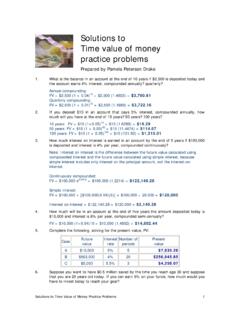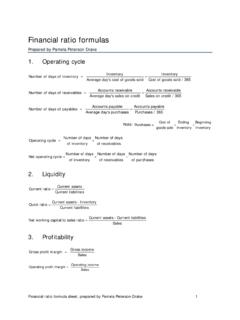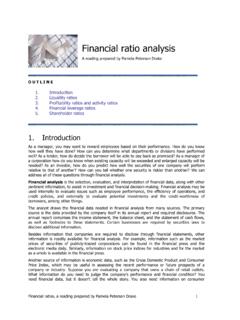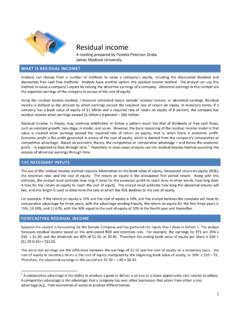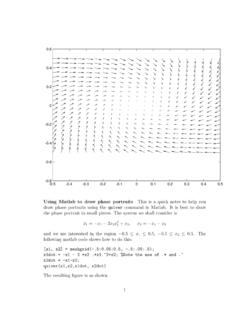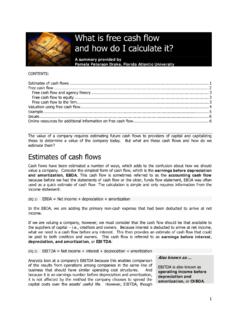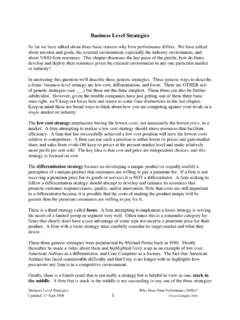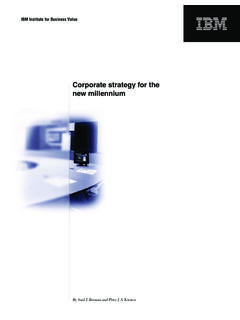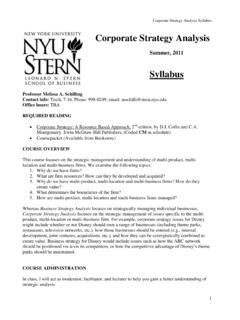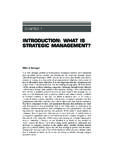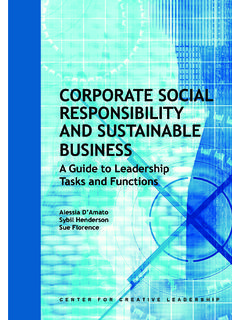Transcription of Corporate Strategy - educ.jmu.edu
1 Corporate Strategy Why Does Firm Performance Differ? Updated: 14 Feb. 2013 1 Scott Gallagher 2003 Corporate Strategy Corporate Strategy is the selection and development of the markets (or industries)1 in which a firm competes. Therefore, Corporate Strategy deals with what industries (or markets) a firm seeks to compete in. Business level strategies (low cost, differentiation, and focus) that were discussed last chapter are HOW a firm competes in a single market or industry. Therefore, Corporate Strategy and business Strategy describe very different issues -- be careful not to confuse them! Unlike business level Strategy , work on Corporate Strategy frameworks is not nearly as advanced or well done. Most emphasis is on describing Corporate Strategy . Describing Corporate Strategy involves two primary dimensions, vertical integration, where firms engage in activities that were formerly done by their buyers or suppliers and diversification where they enter additional markets.
2 While that often gets a lot of attention, How diversified is the firm? is not really that important for understanding why firm performance differs. What really allows Corporate Strategy to result in superior firm performance are what I ll call the building blocks of Corporate Strategy - sharing resources, transferring competencies, and creating specific assets. However, before moving into them, best to go ahead and lay out how Corporate Strategy is described. Describing Corporate Strategy There are two basic descriptive dimensions of Corporate Strategy , how diversified and how vertically integrated an organization is. It may be helpful to think of both of these dimensions as a continuum. Diversification occurs when a firm enters a new industry or market.
3 Just like when we discussed Porter's Five Forces, the definition of an industry or market is critically important. There are formal classification codes, the North American Industrial Classification System (previously Standard Industrial Classification codes see box in external analysis), for trying to classify all industries in an economy. However, for our purposes the NAICS is not very useful. However, it is critical when doing your analysis to carefully define industries in describing firm diversification. For example, was Coca-Cola's move from carbonated beverages into bottled water an instance of diversification? Depending on how you define the industry, it could be yes or no. How diversified a firm is can be determined by what portion of its sales are derived from different markets.
4 The larger a percentage of sales are derived from different markets/industries the more diversified the firm can be said to be. A wide range of labels can be applied to the level of a firm's diversification from single business (95% of sales from one industry), dominant business (70% from one industry) to diversified (less than 70% from any one industry).2 While single business firms are usually found in fast moving, rapidly evolving industries where there is a need to focus, there are exceptions. William Wrigley, the chewing gum manufacturer, is 1 Markets and industries are used interchangeably in this section. Those with economics backgrounds refer to industries and those with marketing backgrounds favor markets.
5 2 Rumelt, R. (1974). Strategy , Structure, and Economic Performance, Cambridge, MA: Harvard University Press. Corporate Strategy Why Does Firm Performance Differ? Updated: 14 Feb. 2013 2 Scott Gallagher 2003 perhaps the most famous single business firm. However, most large firms engage in some diversification. Related vs. Unrelated. Diversification can be either related or unrelated. The key issue here is if the operations of the firm in the new industry share some link in with the firm's existing value chain. Is there some value adding activity that can be shared? For example, is there a production facility, a distribution network, or a marketing competence that both can use? Historically it was thought that related diversification would be better than unrelated diversification.
6 However, the coordination costs of related diversification appear to consume a lot of the expected benefits. Therefore, while most firms seem to engage in related diversification its benefits are only slightly, if at all, better than Vertical integration occurs when a firm takes on activities that were formally done by others on its behalf. In a way, vertical integration is just a special case of diversification, a firm is diversifying into either its suppliers' or its buyers' industries. For example if a company starts to make components for its products on its own or if it starts to distribute products directly to customers it is engaged in vertical integration. Ford Motor Company under Henry Ford was extremely vertically integrated going so far at one time as to own the iron ore mines that fueled its steel mills that fed its automobile assembly However, recently vertical integration has fallen out of favor in preference to contract manufacturing and outsourcing.
7 In fact, outsourcing, the opposite of vertical integration, has become so common that supply chain management has become an important area of study. It will be interesting to see how the expansion of the internet creates opportunities for firms to vertically integrate downstream into direct distribution. A firm's level of vertical integration can be modeled using an industry (rather than a firm) value chain. An industry value chain models all the significant value adding steps that occur in an industry from the most basic raw materials to the final consumers. The more of these activities a firm encompasses the more vertically integrated it is. A firm that enters activities to its left on the industry value chain, replacing a supplier, is said to be vertically integrating "upstream".
8 A firm entering activities to its right, supplanting a buyer, is said to be moving "downstream". So continuing the historical Ford example, Ford buying coal mines would be upstream while him buying a dealership would be downstream vertical integration. Vertical integration entails coordination (bureaucratic) costs just like related diversification. For example, a major issue for vertically integrated firms is transfer prices, what should one part of the firm charge another? Furthermore, a vertically integrated firm faces greater technological risk and demand uncertainty. In many ways vertical integration is a lot like financial leverage, when times are good, they are very good as the firm profits all along the value chain, but when they go bad, it's correspondingly bad all along the value chain.
9 However, both sets of these terms are wholly arbitrary and simply descriptive. If a firm is single business versus dominant business matters little to answering our question of why firm 3 Palich, , Cardinal, and Miller (2000). Curvilinearity in the diversification-performance linkage: An examination of over three decades of research. Strategic Management Journal, 21(2), pp. 155-174. 4 Interestingly though, Ford did not seek to own his dealers. He actually exploited them on several occasions. Corporate Strategy Why Does Firm Performance Differ? Updated: 14 Feb. 2013 3 Scott Gallagher 2003 performance differs. Some value chain function can almost always be claimed as being shared to meet the definition of "relatedness".
10 5 Likewise, vertical integration, upstream or downstream, which is better? Therefore, while it is important to be aware of these descriptive terms, the key issue is how well an organization is able to share resources, transfer competencies and create specific assets regardless of the description of its Corporate Strategy . The Benefits of Corporate Strategy : The Building Blocks of Corporate Advantage All (well 90%+) Corporate Strategy is motivated by what we'll term the three building blocks of Corporate Strategy : shared resources, transferred competencies, and the creation of specific While there are many possible reasons given for things like diversification, they can almost all be traced back to one of these three motivations. Sharing resources is taking something an organization already has and using it in a new industry.


